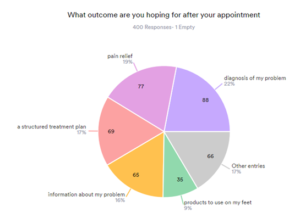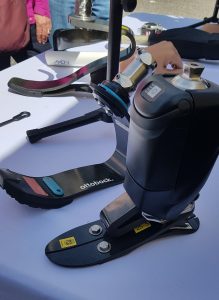People Don’t know what we do
“It’s just my toenails” is the common response when I ask my patients if they are having any trouble with their feet. Sometimes there is shock at our consultation fee because we are “only cutting toenails” after all.
Thankfully, many of our patients understand the true value of having a qualified and experienced team of podiatrists care for your foot health.
Apart from the fact that Podiatrists have a 3 or 4 year University Degree, we also spend many hours of our own time (and our own money) to maintain up-to-date knowledge about the best kind of treatment for your problems. We refine our diagnostic skills, and get updates on the latest medical and surgical procedures you may be having, and how they might impact your feet or the way you walk.
A typical day starts 30 minutes before the first appointment with preparation of the sterilising room. Our ultrasonic cleaner is filled with the correct amount of water and medical grade detergent, then de-gassed and tested to ensure that the instruments we use are properly clean before being sterilised. Likewise our steriliser undergoes a vacuum test prior to use every day to ensure it is functioning correctly. We collect referrals, medical imaging and pathology reports to be attached to patient files, and we ensure that the environment is clean and safe for patients. The ducted air conditioning keeps everything at a comfortable temperature.
We send out final reminders to people to confirm their appointments.
The first patient is a teenager born with an unknown genetic disorder. His gait is very unsteady, and he tends to trip and fall on uneven ground. We have fitted some orthoses to his shoes which have made a significant change to his stability when walking. He can’t tell me how it feels, but if it means he is less likely to fall and break a bone, then we are succeeding.
Next a lady comes in “for her toenails”. I ask her about the lump on the top of her foot which looks like it has been bleeding. She says it’s no bother but I don’t like the look of it. Writing to her GP suggesting further investigation and possible biopsy seems like a big fuss to the lady, but she reluctantly agrees to follow it up.
The next set of toenails belong to a man with a history of drug and alcohol abuse. He has no feeling in his feet and has not noticed the wound under his big toenail. We trim the nail as short as possible, cleanse and dress the wound, and arrange community nursing to follow up with regular dressings at home.
The 8 year old girl with a bleeding ingrowing toenail holds her dad’s hand tight as I examine her. If she doesn’t like what I’m doing she can yell “Jellyfish” and I will stop. With a surgical blade, patience, reassurance and 30 years of clinical experience the offending spike of nail is removed without a jellyfish to be seen. A short discussion and demonstration of how to cut toenails safely, and this little girl will be back at dancing later in the week. Luckily we didn’t have to use a local anaesthetic this time.
Next a concerned daughter brings her Mum who is mid-way through chemotherapy. The potent cocktail of cytotoxic drugs have affected her peripheral nerves so that she has next to no feeling in her feet. The chemo has also damaged her toenails and she has a wound under one of the nails. At this stage in her chemo her immunity is virtually non-existent, so she can’t fight the infection under her toenail, and it could become life threatening without strong antibiotics. I remove the offending toenail, apply appropriate dressings, and then spent the next 15 minutes arranging an urgent appointment with her already busy GP. If she can’t get in with her GP she will need to go to casualty.
A young woman limps through the door. She is lively and attractive, but in terrible pain. The surgery she had as a child to correct a congenital deformity was only partially successful, and now all she wants to do is get on with her life. She is a student with a part time job, but can’t work enough to make ends meet due to her foot pain. The treatment suggested by her specialist will be effective but is too expensive. We have to think outside the box to provide affordable treatment and keep her on her feet, and spend time discussing options including hospital treatment and how to access the National Disability Insurance Scheme. My fear is that the complexity of the system will mean that she does not get the treatment she needs. I spend time on the phone and writing letters to her doctors.
I’m running late now, and the next Gentleman has problems with mobility. It takes him 5 minutes to walk the few metres to my room because he finds it difficult to get his walker in and out of the car. The bandages on his legs have not been changed for a few days and the leg ulcers have been discharging. Consequently the skin on his feet has been moist and his socks and slippers are soaked. I have to clean his feet carefully before looking after his toenails which are embedded in his swollen toes. He leaves wearing one of our pairs of “spare” socks, with a note for the community nurses to review his wounds and dressings.
Admin Break: Catch up on letters and phone calls, and write reports to referring doctors. Ensure patient records are complete and up to date. Chat with admin staff to arrange our twice yearly service and calibration for the steriliser, and to check that monthly payments have been made for Income Tax, Superannuation, Workers Compensation, Professional Indemnity and Public Liability insurance, Goods and Services Tax, and that we have our Fire Safety Inspection certificate.
A man drops in with his elderly Mother’s new sandals. They need modifying because she has a stiff ankle and gets pain in her feet and back when she’s walking. I suggest we check her more thoroughly and work out the exact cause of the problem. It turns out that childhood polio has left one leg shorter than the other so I arrange medical imaging to assess the leg length difference exactly, and get the sandals modified correctly.
The local paper arrives and we see in the Death notices that one of our patients died last week. I have been caring for her for over 15 years, and know the names of her grandchildren and great grandchildren. Some of them have become patients. I make time to attend the funeral, because it helps me to resolve the fact that we do lose a lot of patients. I reflect on the time shared, the trust and confidence which develops where people often relate some of their most closely held experiences, thoughts and feelings.
Our online booking system is playing up…We’ve had a call from a frustrated patient who can’t log in. A quick check reveals a problem with one of our servers. I try everything before calling in IT support and discover that recent storms have damaged our modem and routers, so our internet is slow and intermittent. Thanks goodness it is a quick fix and we are back online the same day. Our use of the latest technology means that we can offer amazing service to our patients which includes online booking, instant claims to Medicare and health insurers, exercise plans delivered by App to your mobile phone, email and SMS reminders for your appointments, among many other small things that you wouldn’t notice.
Well our little server problem has eaten up my lunch break, so I throw down come cheese and biscuits, and take my cup of tea to my next consultation.
This seventy something gentleman is attending for assistance with his toenails and chronic tinea. As he tries to stand I notice his discomfort and he struggles into my room. Yesterday he stepped down a kerb to cross the road and felt something “Give” in the back of his ankle. It was OK at the time but today it is agony. Some simple tests indicate that he most likely has a tear in his Achilles Tendon, so he is immediately splinted in a cam walker and sent back to his GP for an orthopaedic referral. (Later scans indicated that immobilisation had likely prevented a complete rupture.)
Next I am reviewing a patient who has diabetes and has recently had the flu. She explained that her blood glucose levels have been “up and down”. Her skin and toenails are healthy, and using a doppler ultrasound probe we can assess that her peripheral circulation is adequate. On testing sensation however, it becomes apparent that she has lost feeling in her toes and most of her feet beyond the ankles. We tested light touch, temperature, vibration, and pinprick sensation, and all were absent, indicating significant nerve damage. Further assessment will be required by a specialist to be certain of the cause, however it is most likely a complication of poorly controlled blood sugar. I advise precautions due to the lost sensation, and write to her GP.
A colleague is concerned about performing ingrowing toenail surgery on an elderly lady who also has diabetes, and early dementia. She has been in pain for some months, and is not looking after herself very well. The best solution would be permanent removal of the nail, however healing may be an issue. We discuss the options, including the risks associated with not doing anything, and decide to remove the ingrowing part of the toenail under local anaesthetic, but not to cauterise the nail bed. This will give up to a year of relief, and should heal quickly, placing the patient at less risk of complication.
The National Disability Insurance Scheme is having some teething troubles, but we are starting to see lots of people who have previously been unable to access appropriate footcare, splints and shoes or boots. As we have specialist skills in gait assessment, we can identify the best way to assist people to walk safely and without pain. Today we fitted a young man with some new boots which were made to measure for him. The additional stiffness in the heel, and the specially designed soles mean that he can get around without damaging his feet.
Lastly one of Australia’s cycling champions calls in to collect his new carbon fibre orthotics. They are made from a 3D laser scan of his feet, and specially fitted to his cycling shoes at a laboratory in Melbourne. The efficiency gains that he experiences will hopefully give him a faster time in his races. We discuss any adjustments that he may need to make to his bike fit, and wish him well for the next big event.
To finish the day we must complete our report writing and clinical notes, send letters and exercise programs, check our stock, and re-confirm tomorrow’s appointments.
In short, when you visit a podiatrist it is never “just the toenails”. We use our knowledge and experience to make the best diagnoses and treatment goals, using the most appropriate equipment and technology, and we partner with our patients to achieve their hopes and aspirations, whilst often exceeding their expectations.





